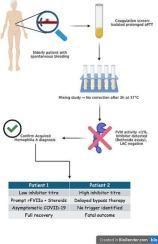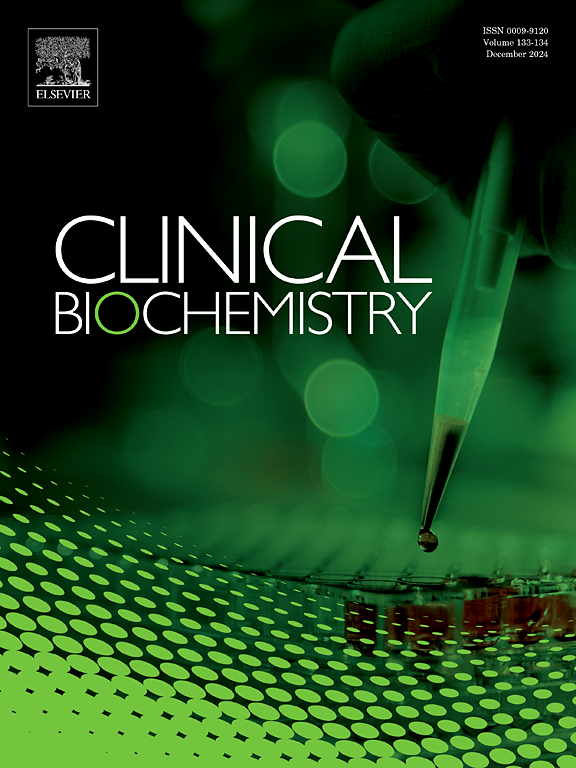实验室和多学科策略在获得性血友病a的早期诊断和救生管理中的关键作用。
IF 2.1
3区 医学
Q2 MEDICAL LABORATORY TECHNOLOGY
引用次数: 0
摘要
背景:获得性血友病A (AHA)是一种罕见但可能危及生命的自身免疫性疾病,其特征是产生针对凝血因子VIII (FVIII)的自身抗体。在没有出血性疾病的个人或家族病史的患者中表现为自发性严重出血。早期发现和快速治疗对于降低发病率和死亡率至关重要。病例介绍:在这里,我们描述了两例老年女性无凝血病史的AHA患者。第一个病例涉及一名81岁妇女,表现为广泛的自发性血肿和严重贫血。实验室结果显示,分离的活化部分凝血活素时间延长(aPTT),检测不到FVIII活性,存在低滴度FVIII抑制剂(2.24 BU/mL)。重组活化因子VII (rFVIIa)和皮质类固醇治疗导致临床改善和抑制剂减少。第二个病例涉及一名85岁妇女,她在输尿管支架置入后出现严重出血症状。凝血研究显示aPTT明显延长,高滴度FVIII抑制剂(165 BU/mL)。尽管开始了免疫抑制治疗,但由于无法控制的出血和多器官衰竭,患者出现了致命的并发症。结论:这些病例强调了考虑孤立aPTT延长和不明原因出血患者可能发生AHA的重要性。及时的实验室诊断,包括混合研究和FVIII抑制剂测定,对于早期挽救生命的干预措施至关重要。多学科管理和快速启动止血和免疫抑制治疗是改善这种具有挑战性的情况的关键。本文章由计算机程序翻译,如有差异,请以英文原文为准。

Critical role of laboratory and multidisciplinary strategies in the early diagnosis of acquired haemophilia a for life-saving management
Background
Acquired haemophilia A (AHA) is a rare but potentially life-threatening autoimmune disorder characterized by the development of autoantibodies against coagulation factor VIII (FVIII). It manifests with spontaneous, severe bleeding in patients without a personal or family history of bleeding disorders. Early recognition and rapid treatment are crucial to reduce morbidity and mortality.
Case presentation
Here we describe two cases of AHA in elderly female patients with no prior history of coagulopathy. The first case involved an 81-year-old woman presenting with extensive spontaneous haematomas and severe anaemia. Laboratory findings revealed an isolated prolonged activated partial thromboplastin time (aPTT), undetectable FVIII activity, and the presence of a low-titre FVIII inhibitor (2.24 BU/mL). Treatment with recombinant activated factor VII (rFVIIa) and corticosteroids led to clinical improvement and inhibitor reduction. The second case concerned an 85-year-old woman who developed severe haemorrhagic manifestations following ureteric stenting. Coagulation studies showed markedly prolonged aPTT and a high-titre FVIII inhibitor (165 BU/mL). Despite initiation of immunosuppressive therapy the patient experienced fatal complications due to uncontrolled bleeding and multi-organ failure.
Conclusions
These cases underscore the importance of considering a possible AHA in patients with isolated aPTT prolongation and unexplained bleeding. Punctual laboratory diagnosis, including mixing studies and FVIII inhibitor assays, is essential for early life-saving interventions. Multi-disciplinary management and rapid initiation of haemostatic and immunosuppressive therapies are key to improving outcomes in this challenging condition.
求助全文
通过发布文献求助,成功后即可免费获取论文全文。
去求助
来源期刊

Clinical biochemistry
医学-医学实验技术
CiteScore
5.10
自引率
0.00%
发文量
151
审稿时长
25 days
期刊介绍:
Clinical Biochemistry publishes articles relating to clinical chemistry, molecular biology and genetics, therapeutic drug monitoring and toxicology, laboratory immunology and laboratory medicine in general, with the focus on analytical and clinical investigation of laboratory tests in humans used for diagnosis, prognosis, treatment and therapy, and monitoring of disease.
 求助内容:
求助内容: 应助结果提醒方式:
应助结果提醒方式:


